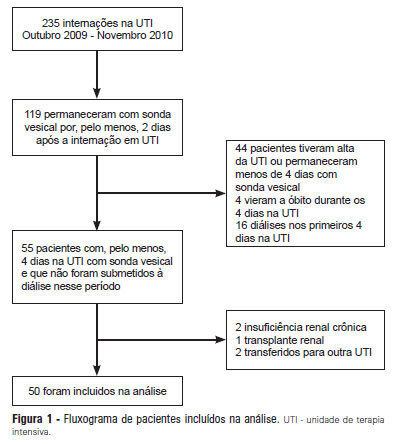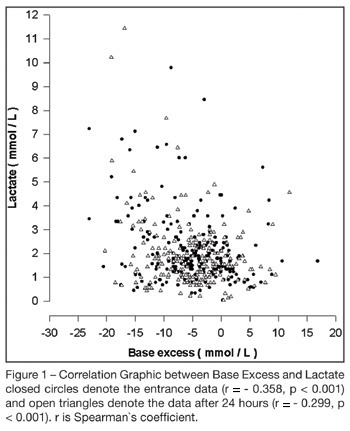Abstract
Rev Bras Ter Intensiva. 2012;24(3):236-245
DOI 10.1590/S0103-507X2012000300006
OBJECTIVE: Intensive care unit survivors and non-survivors have distinct acid-base profiles. The kidney's regulation of urinary electrolytes and the urinary strong ion difference plays a major role in acid-base homeostasis. The aim of this study was to evaluate the potential utility of daily spot urinary electrolyte measurement in acid-base and renal function monitoring. METHODS: We prospectively recorded daily plasma acid-base parameters and traditional markers of renal function in parallel with spot urinary electrolyte measurements in patients with urinary catheters admitted to our intensive care unit. Patients who remained in the intensive care unit for at least 4 days with a urinary catheter were included in the study. RESULTS: Of the 50 patients included in the study, 22% died during their intensive care unit stay. The incidence of acute kidney injury was significantly higher in non-survivors during the 4-day observation period (64% vs. 18% in survivors). Urinary chloride and sodium were lower and urinary strong ion difference was higher on day 1 in patients who developed acute kidney injury among both survivors and non-survivors. Both groups had similar urine output, although non-survivors had persistently higher urinary strong ion difference on all days. Survivors had a progressive improvement in metabolic acid-base profile due to increases in the plasma strong ion difference and decreases in weak acids. These changes were concomitant with decreases in urinary strong ion difference. In non-survivors, acid-base parameters did not significantly change during follow-up. CONCLUSIONS: Daily assessment of spot urinary electrolytes and strong ion difference are useful components of acid-base and renal function evaluations in critically ill patients, having distinct profiles between intensive care unit survivors and non-survivors.

Abstract
Rev Bras Ter Intensiva. 2006;18(1):22-26
DOI 10.1590/S0103-507X2006000100005
BACKGROUND AND OBJECTIVES: To correlate standard base excess (SBE) with serum lactate level and demonstrate the independent prognostic significance of each one. METHODS: In a retrospective study, we retrieved data from 333 patients of our prospectively collected database of 7-bed medical intensive care unit of a 1800-bed university hospital. RESULTS: The results have shown a poor correlation between SBE and lactate, r = - 0.358, p < 0.001, and an independent prognostic significance of each one when analyzed concomitantly, odds ratio (95% Confidence interval) = 0.996 (0.992 - 0.999) to standard base excess and 1.000 (1.000 - 1.002) to lactate at entrance; and odds ratio (95% Confidence interval ) = 0.990 (0.985 - 0.994) to standard base excess and 1.003 (1.001 - 1.005) to lactate after 24 hours. The accuracy of standard base excess was close to lactate to determine in-intensive care unit death. CONCLUSIONS: The lactic component of the metabolic acidosis is not the major determinant of standard base excess. Serum lactate and SBE are independent outcome predictors in critically ill patients.
